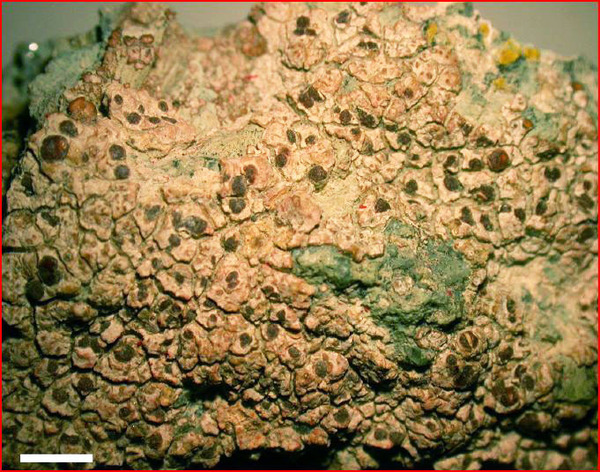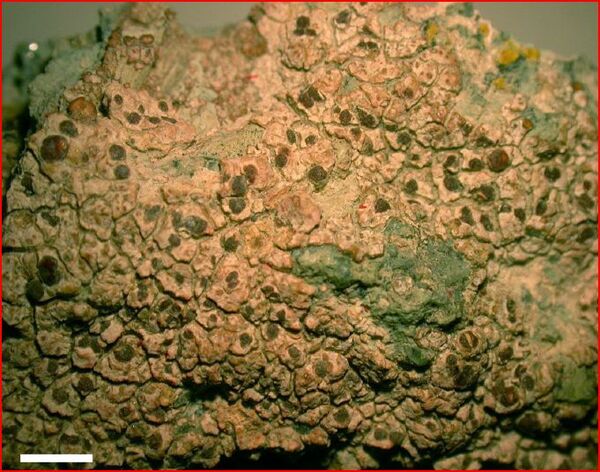Acarospora trachytica Jatta
N. Giorn. Bot. Ital., 14: 127, 1882.
Synonyms:
Distribution: S - Camp (Ricciardi & al. 2000, Knudsen & Nordin 2015).
Description: Thallus crustose, episubstratic, rimose-areolate, the areoles 1-2 mm wide, up to c. 0.7 mm thick, white to pinkish white, turning green when wet, rugulose, broadly attached, without a distinct lower surface. Cortex paraplectenchymatous, 30-40 μm thick, with an up to 40 μm thick epicortex, the cells inspersed with minute granules; algal layer even, continuous; medulla white, heavily inspersed with crystals. Apothecia round, up to 1 mm across, usually one per areole, with an epruinose, flat to convex, reddish brown to reddish black disc, without a distinct thalline margin. Proper exciple indistinct; epithecium brownish; hymenium colourless, 100-120 μm high, the hymenial gel euamyloid, IKI+ persistently dark blue; paraphyses 2-2.5 μm thick at base, the apical cells hardly swollen; subhymenium deep up to 150 μm high; hypothecium indistinct. Asci 50-100-spored, clavate, the apical dome K/I-, 75-90 x 18-24 μm. Ascospores 1-celled, hyaline, globose and 4-6 μm in diam., or subglobose and 4-6 x c. 4 μm. Pycnidia visible as pink dots. Conidia simple, hyaline, c. 2 x 1 μm. Photobiont chlorococcoid. Spot tests: cortex and medulla K+ yellow turning red (needle-like crystals), C-, KC-, P+ yellow, UV-. Chemistry: norstictic acid. Note: the lectotype in UPS is on light trachyte pigmented with a red mineral, and the second syntype is on calcareous tufa (Jatta 1882). The species is currently known only from coastal Italy in the region of Naples. For a detailed description of this long-forgotten, but well-distinct species see Knudsen & Nordin (2015).
Growth form: Crustose
Substrata: rocks
Photobiont: green algae other than Trentepohlia
Reproductive strategy: mainly sexual
Commonnes-rarity: (info)
Alpine belt: absent
Subalpine belt: absent
Oromediterranean belt: absent
Montane belt: absent
Submediterranean belt: absent
Padanian area: absent
Humid submediterranean belt: extremely rare
Humid mediterranean belt: extremely rare
Dry mediterranean belt: very rare

Predictive model
Growth form: Crustose
Substrata: rocks
Photobiont: green algae other than Trentepohlia
Reproductive strategy: mainly sexual
Commonnes-rarity: (info)
Alpine belt: absent
Subalpine belt: absent
Oromediterranean belt: absent
Montane belt: absent
Submediterranean belt: absent
Padanian area: absent
Humid submediterranean belt: extremely rare
Humid mediterranean belt: extremely rare
Dry mediterranean belt: very rare

Predictive model
 INDEX FUNGORUM
INDEX FUNGORUM
 GBIF
GBIF



